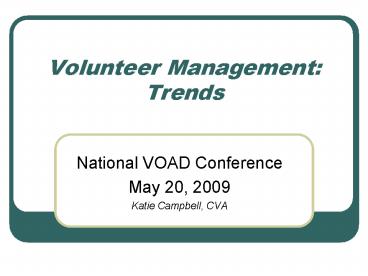Volunteer Management: Trends - PowerPoint PPT Presentation
1 / 27
Title:
Volunteer Management: Trends
Description:
'Are Paid Workers in Danger of Being Usurped by an Army of Volunteers? ... SMASHED (Society of Mature Adults Seeking to Help, Entertain & Donate): Ages 25-35 ... – PowerPoint PPT presentation
Number of Views:146
Avg rating:3.0/5.0
Title: Volunteer Management: Trends
1
Volunteer ManagementTrends
- National VOAD Conference
- May 20, 2009
- Katie Campbell, CVA
2
Headlines What Do They Tell Us?
- Are Paid Workers in Danger of Being Usurped by
an Army of Volunteers? - Volunteer Crime-Fighters Past Prime at Age 16
- Border Chief Reaches Out to Volunteers
- Bartering Comes Back
3
Headlines What Do They Tell Us?
- Boomer Volunteers Often Give Up Duties
- Dont Call Them OldCall Them OPALS
- From Ranks of Jobless, a Flood of Volunteers
- The Edward M. Kennedy Serve America Act
4
The Serve America Act
- Expands the focus of the National Civilian
Community Corps (NCCC) to include disaster relief - Encourages service partnerships with other
federal agencies and increases participation of
disadvantaged youth to 50 of program
participants by 2011. - Establishes an alumni corps of former AmeriCorps
members to respond in emergencies.
5
Facts and Figures
- Take the Quiz and Test your Knowledge!
6
Facts and Figures
- 1. What percentage of the U.S.
- population (age 16 and older)
- volunteered in 2006?
- A. 26.7
- B. 28.8
- C. 49.3
- D. 51.6
7
Facts and Figures
- 2. On average, what percentage of
- U.S. volunteers who served in 2005 continued
in 2006? - A. 54
- B. 66
- C. 75
- D. 81
8
Facts and Figures
- 3. Most volunteers do not perform service
- activities that relate to their professional
or occupational skills. - TRUE or FALSE?
9
Facts and Figures
- 4. What percentage of adults ages 51-59
- are regularly accessing the internet?
- A. 51
- B. 59
- C. 72
- D. 81
10
Facts and Figures
- 5. A larger percentage of adults volunteer
- through religious organizations than through
any other type of organization. - TRUE or FALSE?
11
Facts and Figures
- 6. What percentage of nonprofits train
- their paid staff to work with volunteers?
- A. 19
- B. 36
- C. 53
- D. 72
12
Facts and Figures
- 8. Smaller organizations tend to make
- greater use of a greater variety of
- volunteer skills.
- TRUE or FALSE?
13
Facts and Figures
- 8. What percentage of nonprofits regularly
- recognize the contributions of volunteers?
- A. 35
- B. 55
- C. 80
- D. 97
14
HOW are PeopleVolunteering?
- SMASHED (Society of Mature Adults Seeking to
Help, Entertain Donate) - Ages 25-35
- Combine social fun with service
- Willing to fundraise
- in their own way
15
HOW are People Volunteering?
- Self-initiated, social entrepreneurs
- Starting new nonprofits
- Low confidence in established organizations
- All ages
16
HOW are People Volunteering?
- Self-directed teams
- A group of volunteers who have day-to-day
responsibility for managing themselves and the
work they do with a minimum of outside
supervision. - Service delivery, problem-solving, projects,
leadership teams
17
HOW are PeopleVolunteering?
- Skills-based assignments
- Using the same skills as a volunteer that are
used in ones paid occupation. - More common legal, sales/marketing,
education/teaching - Less common arts/design, media, entertainment,
health care, public safety, management,
office/admin. support
18
HOW are People Volunteering?
- Via the Internet
- Blogging and listservs have surpassed email
- Internet portals are critical to the visibility
of volunteer opportunities - Websites must include clear pathways to engagement
19
HOW are People Volunteering?
- Voluntolds
- Mandated by schools, colleges, courts,
government, or physicians - Short-term and long-term
- Diversity of backgrounds
- and skills
20
Changing Generational Characteristics
Traditionalists
Boomers
Gen-Xers
Millennials
Self-reliant and independent questions
authority, respects competence, not titles
Entrepreunrial Self-confidence, sense of
individuality and uniqueness
Suspicious of organizations anti-authoritarian
motivated by self-fulfillment
Valued civic duty, respect for authority,
blending in, following the rules, organizational
loyalty
Increasing Individuality
21
From Collective to Reflexive
Volunteering
- Collective Volunteering
- Collective action through
- membership in nonprofits,
- clubs, churches, etc.
- Reflexive Volunteering
- Reflexive (self-referential)
- action, based on individual
- interests, motivations and
- needs.
- Hustinx and Lammertyn, 2003
22
Shifting ourManagement Paradigm
23
Appealing to Boomers
- Describe the specific challenges your
organization faces - Emphasize the degree of independence and
flexibility you can offer - Re-think your interview questions
- Ask them to recruit others they are connect to
- Use updated language in messaging
- Organize work in collaborative teams
- View highly skilled volunteers as consultants
- Offer opportunities to connect with top leadership
24
Embracing a New Language
- OLD NEW
- volunteer management . volunteer engagement
- recruitment .. cultivation, networking
- placement ... negotiation, agreement
- supervision .. support
- recognition .. acknowledgement
- retention sustainability
- formal, informal civic engagement
- Source Boomer Volunteer Engagement, by
Fixler, Eichberg Lorenz, 2008.
25
New Perceptions of Our Role
- How we view our role
- and describe it to others
- Talent Manager
- Translator
- Facilitative Leader
26
The Myth of the Rugged Individualist
- I think I am starting to get it.
- I have to give up some control, dont I?
27
Our Choices































